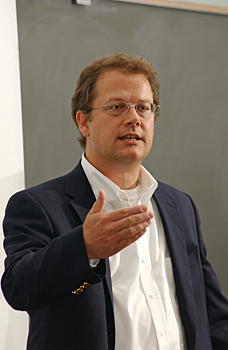
Schultz made his remarks to more than 50 students, faculty and community members during a colloquium sponsored by UD's Department of Psychology on Oct. 17 in Gore Hall.
A 1983 graduate of UD with a bachelor's degree in psychology, Schultz is president of the International Society for Autism Research and was most recently Harris Endowed Associate Professor and director of the Developmental Neuroimaging Program at the Yale Child Study Center, where he performed groundbreaking research on the brain regions underlying social deficits in autism. He currently holds an endowed chair at CHOP.
“With the advent of modern neuroimaging techniques such as magnetic resonance imaging (MRI), it is now possible to describe and discover important aspects of behavior, both typical and atypical,” Schultz said. “It is an exciting era, as we can now look in vivo at brain structure, connections and brain activity and begin to understand how brains work differently in different individuals.”
Schultz said that researchers are learning that in individuals with autism, there are specific differences in an area of the brain called the temporal lobes, located directly behind each ear.
“The temporal lobes have long been known to govern aspects of language and social communication,” Schultz said, “But my program of research, as well as research done by others, now is showing that it is likely that the temporal lobes are the source for many of the problems that define autism.”
As an example, Schultz noted that researchers have found that in those with autism the connections between neurons in the temporal lobes are abnormal, and in some areas they are overly connected or wired, but in other areas they are not connected strongly enough.
“What is exciting is that in these same areas where we are seeing real anatomical differences, we are also measuring functional differences with fMRI (functional MRI),” Schultz said. “My research has focused on face recognition and some other aspects of social cognition, and we now feel confident in asserting that the abnormalities that we see in the temporal lobes figure prominently in the neural mechanisms that cause some of the core signs and symptoms of autism.”
Schultz said that autism was first described by Leo Kanner in 1943, at Johns Hopkins Hospital in Baltimore.
“He wrote the original paper, and you can still get insights into what autism really is by going back and looking at his paper,” Schultz said. “He talked about autism having two important features: an inward focus and lack of interest in other individuals, and a resistance to change.”

Some researchers believe that these defining characteristics are interactive, and in this way give rise to other features of autism not covered in this diagnosis, including mental retardation, sleep disturbance and unusual food preferences, Schultz said.
The autistic spectrum disorder includes individuals with Asperger syndrome, as well as a third group, PDD-NOS (Pervasive Development Disorder-Not Otherwise Specified), also called atypical autism, Schultz said.
“Insensitivity to social rewards remains just one theory attempting to explain the development of autism,” Schultz said. “It is an attractive theory, because it attempts to account for development starting at the youngest possible age. Other theories often only explain part of autism, or at a level of explanation that cannot account for the earliest portions of development.”
At Children's Hospital of Philadelphia, Schultz will join an existing program that investigates the early identification and prevalence of autism, and will be adding his research efforts to those of scientists at the Center for Autism Research in the use of other imaging techniques.
Funded by the Autism Centers of Excellence grant program of the National Institute of Mental Health, the new brain-imaging study will produce brain images of young children with an older sibling already diagnosed with autistic spectrum disorders. An additional large-scale imaging study will involve school-age children and young adults with Autistic spectrum disorders. Families interested in possibly participating in these studies should e-mail Robert Schultz at [Schultzrt@chop.edu].
“I will be focused on understanding why children with an autism spectrum disorder can be so different from one another,” Schultz said. “While they share many features, they each are unique, and together with my new colleagues, I will be studying the biological and other influences that make them unique.”
Schultz, who received his doctorate in clinical psychology with a focus in neuropsychology from the University of Texas at Austin, also is the recipient of a series of grants from the National Institute of Child Health and Human Development, the National Institute of Mental Health, the National Institute of Neurological Disorders and Stroke, the James S. McDonnell Foundation and the National Science Foundation. He also has received funding from private sources such as the National Association for Autism Research, and his work has been reported on in The New York Times and Newsweek, and on 20-20 and CNN.
Article by Jerry Rhodes
Photos by Duane Perry

